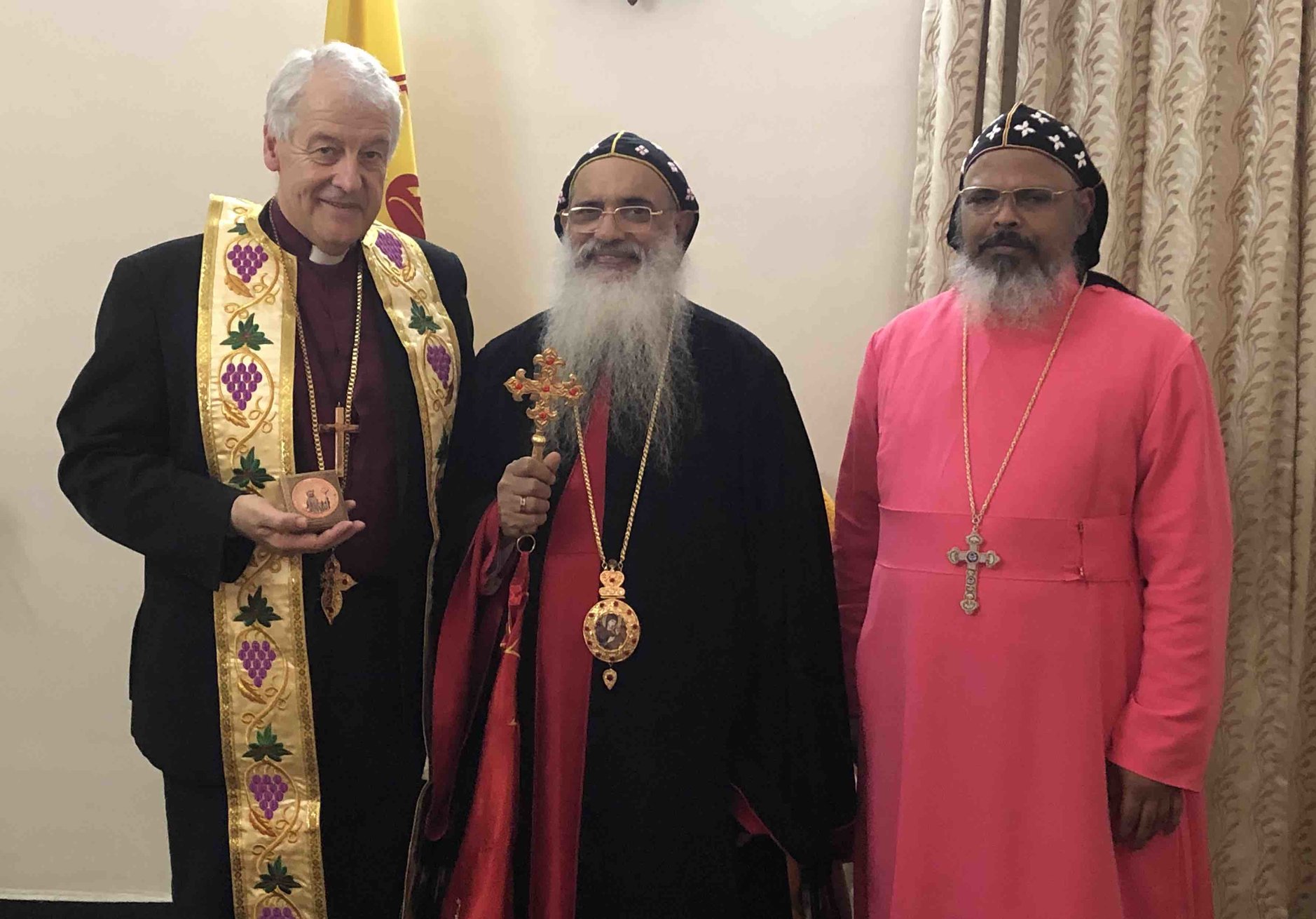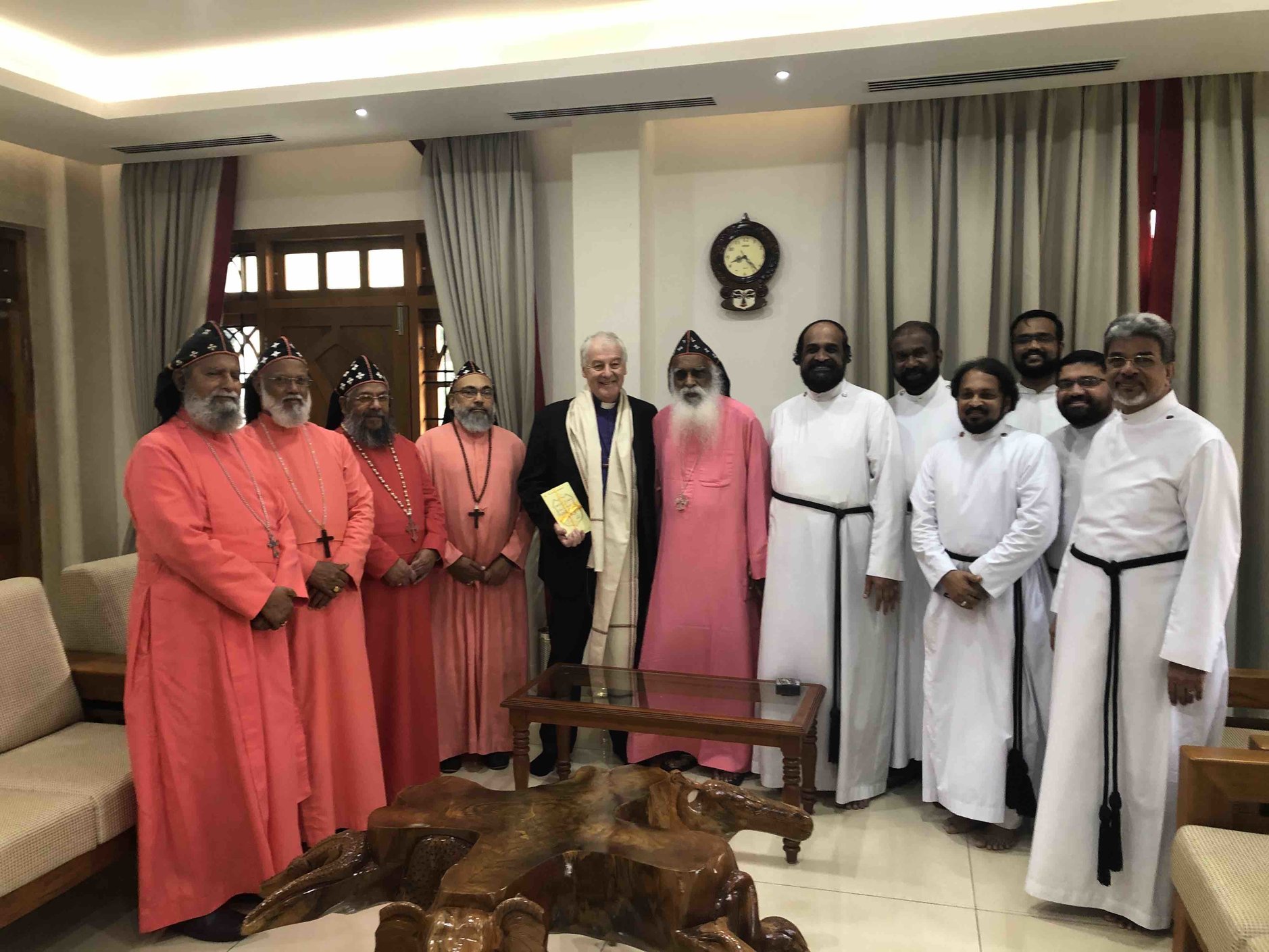Photo – Archbishop Michael Jackson with the Catholicos of the Malankara Orthodox Syrian Church and Metropolitan Timotheus.
Archbishop Michael Jackson is currently visiting the Malankara Orthodox Syrian Church, also known as the Indian Orthodox Church. The church is based in the Indian state of Kerala and during his visit the Archbishop is worshiping in a number of parishes. He is also attending a number of presentations and talks.
## Day 5
On Thursday (August 1) Archbishop Jackson visited a city centre parish of the Mar Thoma Church where he met the parish priest, a recently ordained deacon and a number of parishioners. The church was built in 1902 and has a parish membership of 800 families.
The Church of Ireland is in communion with The Mar Thoma Church as also with CSI and CNI. The Mar Thoma tradition worships in St Catherine’s, Donore Avenue and in St Maelruain’s Church, Tallaght.
From there he went on to The Mar Thoma Seminary which trains clergy for service in the church and also has a research wing with all degrees being validated by Serampore University. This Seminary works in close association with the CSI Seminary and the Malankara Orthodox Syrian Seminary. The Archbishop had the opportunity to discuss aspects of theological training for lay and clerical students and to talk about a number of the issues of theological and pastoral concern in the Christian Churches of India today. Examinations were taking place upstairs for students hoping to enter the seminary next year. His Holiness the Catholicos of the Malankara Orthodox Syrian Church granted the Archbishop an audience. As well as having the privilege of meeting The Catholicos, the Archbishop met Metropolitan Timotheus who has responsibility for a diocese in Kerala and also for the communities in the UK and Ireland.
Both The Catholicos and Metropolitan Timotheus are deeply appreciative of the hospitality offered by the Church of Ireland. They are also very excited by the prospect of the building of a new church in the Malankara Orthodox Syrian tradition in Lucan in County Dublin in the near future. This will be the first such Orthodox church in Ireland. The hope of the Archbishop would be that the Dioceses of Dublin and Glendalough might offer support to this project which has already secured a site and planning permission. From the headquarters of the Church and the home of The Catholicos, who was heading off to his ashram immediately after the meeting to spend forty eight hours in silence, fasting and prayer, Archbishop Jackson went to the Orthodox Theological Seminary. There he was again greeted by Metropolitan Timotheus and also by the Principal and staff and Metropolitan Justus whose diocese includes the birthplace of Mahatma Ghandi. Throughout his time he was guided and looked after by one of the deacons.
The Seminary was built in 1815 and began, not as a place of theological education or formation, but as an educational institute where local people were taught reading and writing and the law. For a period it also housed CMS Missionaries. Today it has an annual intake of 135 students and the liturgy alternates between Syriac and Malayalam.
The Archbishop was invited to preach on a text from St Luke 4 where Jesus was rejected by those among whom he grew up and where he wisely slipped away through the crowd when the people sought to throw him down the cliff in their anger at his holiness and his spirituality and his being an embodiment of Scripture. The Archbishop explored the following themes as St Luke unfolds the story: the need for the sort of preparation which Jesus did when he worked his way through the Temptations of Satan in the desert; the ways in which people are quite happy to hear Holy Scripture read so long as it does not have any practical outcomes; the courage shown by Jesus, and today required of his disciples, in drawing those at the centre to the margin and those at the margin to the centre as compassion and justice meet and act. The Archbishop had the opportunity to enjoy a cultural programme of music and dance and to eat dinner with the students and staff.
Archbishop Jackson with the Metropolitan of the Mar Thoma Church, a number of its Bishops and some staff of the Metropolitan.
## Day 6
On the sixth day of his visit to Kerala, Archbishop Jackson travelled to meet the Metropolitan of the Mar Thoma Church. The Mar Thoma Church embraced a Reformed version of Indian Orthodox Christianity and is in communion with the Church of Ireland through our being members of the Anglican Communion. The three traditions visited by the Archbishop work together around theological education and research while they have their own distinct styles of worship and their distinct outreach programmes to the dispossessed and the marginalised.
The Metropolitan and the Archbishop had already met in St Maelruain’s Church, Tallaght, where Canon William Deverell is Rector when the Metropolitan visited Ireland. They spoke of the worldwide character of the Mar Thoma Church, its having communities in almost every country and churches similarly except in South America.
Once a year representatives from the churches and parishes across the world come to the Headquarters for the Meeting of the Synod, akin to our General Synod. The bishops had just completed a meeting of their own synod (gathering) and they, together with the Archbishop, members of staff and Father Ashwin who has been the Archbishop’s host throughout his visit, had breakfast with the Metropolitan who is a hearty 89 years old. The Archbishop was shown the media centre and the museum both of which are located in the original house built for the Metropolitan. The Archbishop then made a very special visit to pray with the Metropolitan Emeritus who is 102 years old and in the last few months has moved into hospital on a full time basis. Reflecting on the visit, a number of interesting issues come to the fore. The first is the ways in which all three traditions – Indian Orthodox, Mar Thoma and CSI – are integrated into the society of contemporary India. This is reflected strongly in the programmes of outreach to the poor, the marginalised and the dispossessed. It is reflected also in the different styles of worship that may be found in each of the churches which cater for a range of expectations.
Another important facet of the life of the churches is that mission is part of their DNA. The work of God marches hand in hand with the word of God. The third aspect is that, as India is a country of so many cultures and regions and languages, Inter Faith engagements simply are part of everyday life. Faith traditions are and remain distinct. However, the Christ–inspired instinct to find your neighbour in the person right in front of you, irrespective of faith or social standing, is a lasting memory and inspiration to go and do likewise.
d548bb139650fe41c4403467a364f608.jpg
02dcdb93aaf8f5a04e9f75dca1ce9924.jpg




